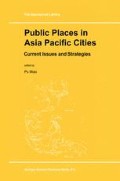Abstract
The cities of Thailand face the challenges of rapid growth and social transformation. Yet there is a relative absence of local models to directly help in dealing with these new conditions and their demand for high density construction. The existing context may, however, provide more subtle architectural provocations: clues for an approach in the absence of clear models to follow. An analysis of Mae Hong Son, a small town in the north of Thailand, reveals consistent traits and attitudes for future extrapolation. Most notably there is an intriguing friction between form and use. Present in both intentional and accidental situations, this reveals a potent urbanism awaiting investigation.
Access this chapter
Tax calculation will be finalised at checkout
Purchases are for personal use only
Preview
Unable to display preview. Download preview PDF.
Notes
The negative aspects of this growth, and its fragility, have been exposed through the banking and exchange crisis starting in the fall of 1997. Some buildings, whose virtues were only really as vehicles for financial speculation, remain as empty monuments to this international-style growth.
For discussion on urban development pattern, see Norton Ginsburg et al., eds., The Extended Metropolis: Settlement Transition in Asia ( Honolulu: University of Hawaii Press, 1991 ). However, the architectural implications of this development are not addressed in the book.
See the early skyscrapers of New York or Chicago, for example. Both cities are populated with Florentine and Venetian buildings, vertically accentuated. Even the theory of the early skyscraper borrowed directly from the classical tradition and its tripartite ordering principles. H.R. Hitchcock, Architecture, Nineteenth and Twentieth Centuries ( Baltimore: Penguin, 1958 ), p. 236.
For example, see William Warren, “Thais Honor Their Proud History” and Robin Dannhorn, “Growth through Diversity” in the special insertion celebrating the King’s Golden Jubilee, International Herald Tribune,May 1996, pp. 2 and 4 respectively. These articles combined pride in a rich history with concerns and ideals for future development. A strict historicist approach to new building contradicts this intriguing balance.
The question of urban amenity is a recurring one within the press. Traffic, public space and civic quality, and the larger question of development, are subjects of detailed examination; for example, see Walakkamon Eamwiwatkit, “Monks on the March” and Kwanchai Rungfapaisarn, “Traffic Jams Still Bangkok’s Drive for Hub Status,” The Nation,July 5, 1995, p. Cl. In addition, our contacts at Chulalongkorn University in Bangkok and Prince of Songkla University in Hat Yai were very helpful.
This paper derives from a larger study, carried out over two summers of field work in Mae Hong Son. This research investigated the structure of the city and its parts, and its development potential. Specific proposals testing the role of architectural design within urban research were also undertaken to further extrapolate from the themes discovered through analysis.
I was once invited to address the morning convocation of a local state residential school. For these occasions the students dress in their traditional clothing, celebrating their distinctiveness within the overall culture.
This contrasts with Wats elsewhere, such as in Chiang Mai. There they follow cardinal rules of orientation, usually facing east or north, but do not defer to a specific landscape feature.
New programs, such as hotels and large government offices, which require a stricter expression of program, exist presently in the outskirts of the city. They demonstrate the problems facing recent development rather than the solutions, as they tend to resort to the stylistic application referred to earlier. One building type which was consistently interesting, however, were the schools. Though it is not possible to address them here, they deserve further study in the search for design possibilities inherent in larger programs.
Author information
Authors and Affiliations
Editor information
Editors and Affiliations
Rights and permissions
Copyright information
© 2001 Springer Science+Business Media Dordrecht
About this chapter
Cite this chapter
Bell, B. (2001). A Question of Local Models: Public Spaces in Mae Hong Son, Thailand. In: Miao, P. (eds) Public Places in Asia Pacific Cities. The GeoJournal Library, vol 60. Springer, Dordrecht. https://doi.org/10.1007/978-94-017-2815-7_15
Download citation
DOI: https://doi.org/10.1007/978-94-017-2815-7_15
Publisher Name: Springer, Dordrecht
Print ISBN: 978-90-481-5739-6
Online ISBN: 978-94-017-2815-7
eBook Packages: Springer Book Archive

